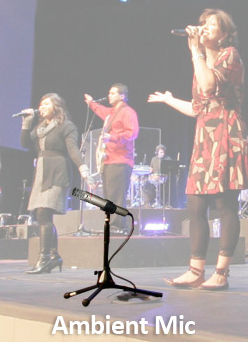Music is often considered the pinnacle of art; a clearly expressive showing of emotion, message and culture. When created in a group, a collaboration must be present in order for the end result to sound coherent and inspiring.
With worship music in particular, a high level of collaboration must occur in order to lead a group of people in worshiping God. The bass guitarist and drummer must be working together to build the groove of the song. The guitars and keyboards must each fill their own spaces in order to provide the body and melody of the music.
On top of that, singers must be out front leading people in adoration of God. We’ve all heard great worship teams and those who struggle. Most often I find it’s their ability to work together that defines the separation.
Eliminate Stage Volume
Over the past decade in-ear monitoring has helped eliminate stage volume and has given musicians a good, safe way to hear the things they need to hear in order to succeed in leading worship. The further advent of personal monitor mixing systems has brought great advantage to worship musicians, giving them control over what they hear and allowing the ultimate in flexibility.
One trap I’ve seen many musicians fall into with personal monitor systems, however, is focusing so much on hearing themselves that they don’t bring up the other instruments that they’re supposed to be interacting with. They’re no longer listening to make sure they aren’t playing on top of other musicians, they aren’t listening to the drums and bass to make sure they’re in time, and sometimes, they aren’t bringing the leader up in order to hear directions. They’ve taken isolation too far.
How It Started
For years touring musicians have used in-ear monitors in order to hear better and protect their hearing. By decreasing the audio clutter and volume on stage, IEMs allowed musicians to clearly hear what they were doing while at the same time minimizing the impact of stage volume on the house—which front of house engineers loved.
High-dollar tours had monitor engineers on stage running their in-ear mixes or huge consoles at front of house to run them from there. This simply wasn’t practical for most venues, so churches continued to struggle with stage volume. But nearly a decade ago it all changed with the introduction of personal monitor mixers.
However, personal monitoring isn’t meant to create silos on the stage, but rather, is designed to allow musicians to safely and more clearly hear the things they need to hear in order to better produce their art. I’d like to challenge performers who made the jump to personal monitoring a while ago to really listen to their mixes and see if they can hear everything they need to hear to be a part of the worship collaboration.
For sound operators and musicians just getting started or are thinking about it, personal monitor systems are an awesome tool, but make sure you don’t turn the quest for clarity into too much isolation.
Need For Ambient Mics
It’s not just interaction with the band that is critical for musicians. Another common complaint musicians have is a feeling of isolation from what is happening with the congregation and in the room.
I’ve installed many of these systems over the years and there is a common denominator between the ones that musicians are happy with versus the ones they’re frustrated with: ambient mics. As we’ve already discussed, musicians need some isolation from the sound on stage in order to clearly hear what they need to hear, but music is an art—and artists need to feed off of other artists as well as the people receiving that art.
The bottom line is that ambient mics help create the right blend of isolation and inclusion for each person. While I don’t have a must-use model of ambient mic (I often use the cost-effective AKG C 1000), I do prefer mics with cardioid pickup patterns hung in the house with the back of the mic aimed towards the loudspeakers. The idea is to reject as much of the sound system as possible while picking up the room.
If you can’t hang the mics, placing them on the front of the stage, pointing slightly down and into the audience, can work too. Ultimately, two mics in the house blended into a single channel fed to personal monitor mixers can make a world of difference in a musician’s feel (and by the way, these ambient mics can improve your recordings too).
If you want some additional coverage, adding another mic or two in the stage area (away from the drums) can also help the band communicate with each other and hear some of what they would be hearing if they didn’t have in-ears or headphones on.
They’re A Must
I don’t believe there’s only one “right” way to set up ambient mics, but I do believe that including ambient mics with personal monitor systems is a must. Find what’s right for you and your room, but whatever helps the band connect with each other and the congregation is a good thing. In fact, that connectedness may be the difference between your musicians using them or not.
In the end, personal monitors were never created to isolate artists from other artists—or artists from the congregation—but rather, to create enough isolation from the sound on stage so that they can hear well enough to do their part with excellence.
In order to implement personal monitoring systems effectively, there must be a balance between isolation and inclusion. Ensuring good interaction with musicians and the congregation can make the difference between awkward music and awesome worship.
Duke DeJong has more than 12 years of experience as a technical artist, trainer and collaborator for ministries. CCI Solutions is a leading source for AV and lighting equipment, also providing system design and contracting as well as acoustic consulting. Find out more here.

























